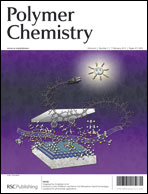Synthesis and NMR investigation of styrene glycopolymers containing d-galactose units functionalized with 4-(4-hydroxybutoxy)benzylamine residues†
Abstract
As a part of a work aimed at the synthesis of properly functionalized nanostructured glycopolymers suitable for interaction studies with copper amine oxidases, D-galactose was transformed through a six step sequence into the monomer N-(4-vinylbenzoyl)-6-amino-6-deoxy-D-galactose (1) which was converted into nanostructured crosslinked polymers (R1) by radical precipitation polymerization and into linear polymers (P1) by solution polymerization. The linear polymers were useful models for setting up glycosylation reactions to introduce N-trifluoroacetyl-4-(4-hydroxybutoxy)benzylamine residues in the presence of camphor sulfonic acid as the catalyst and to extend them to the nanostructured systems. The advancement of the glycosylation reaction was performed through the synthesis and glycosylation of N-benzoyl-6-amino-6-deoxy-D-galactose (9) as the model molecule for accurate NMR investigations. The removal of the trifluoroacetyl protecting group, unexpectedly stable, in glycosylated P1 and R1 was achieved with sodium borohydride.


 Please wait while we load your content...
Please wait while we load your content...